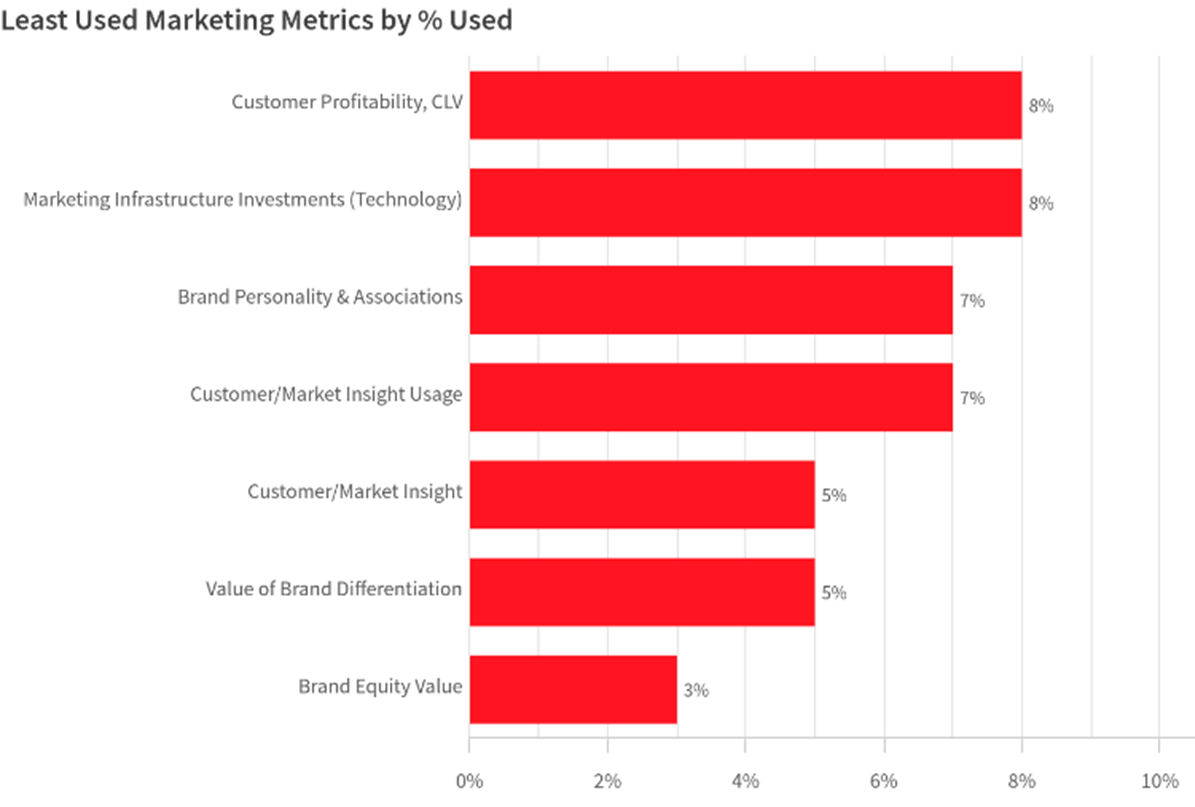Measuring how marketing is helping to drive your business is critical. But often marketing’s impact is not widely understood and appreciated.
If we look at marketing holistically, its purpose is to drive company growth by building awareness, meeting customer needs and effectively positioning brands. Many CEOs, however, don’t see marketing as measuring up. Recent research aimed at understanding how CMOs are viewed showed the CEO’s biggest concern was marketing’s ability to drive company growth.
Now, why is that? Marketing budgets are typically 10-15% of company revenue, so the investments are not small! However, often marketing departments face challenges in delivering strategic objectives that are assessed on tactical outcomes. The impact of the pandemic and current global climate has understandably made leadership more myopic, with a focus on quick wins and quarterly success. So how can marketing, a function with an inherently long-term view, show true value in the short run?
The answer is having a 360° customer view with a firm grip on data and analytics. In recent times, the expectations of the marketer and data analyst have become more blurred, as leadership expects deeper insights into what is moving the needle. But are marketers looking in the right areas? Let’s first consider the expectations – a recent study showed that CMOs are 59% more likely to be involved in driving their organization’s vision if they provide three or more types of data to overall business measurement framework, including:
Market insights
Market opportunities
Competitive insights
Brand health
Customer needs
CMO Survey Shows Large Data Gaps
Worryingly, the 2021 CMO study published by Deloitte showed that these metrics rank in the least-used by marketers! This is counter-intuitive – surely the marketing KPIs sought after by the board would be most often used? If we look at each of these categories more closely, we can see the reason behind the gaps.

Figure 1**: Most Used Marketing Metrics (Deloitte - 2021 CMO Survey)**
Here we can see a couple of key similarities. First, these metrics are vital to the performance of marketing operations, which isn’t in debate. However, they are ‘first order’ metrics that are straightforward to establish. Sales revenue, for example, can be quickly pulled from any CRM system. Similarly, content engagement can be found by the number of interactions with a particular element, and lead generation can be identified by the number of leads that tie back to a particular campaign code. While this data is powerful, perhaps part of the reason these metrics are so commonly used is that they are more clear and readily evident.

Figure 2**: Least Used Marketing Metrics (Deloitte - 2021 CMO Survey)**
However, when we consider the least used metrics, we can see that these are just as important, but nowhere near as straightforward to establish. In fact, these measures could be considered ‘higher order’ metrics that require far more detail to fully describe and understand. Taking a closer look, these metrics can be categorized into two broad groups – detailed customer insights, and detailed brand insights. For the sake of brevity, we will look at one metric from each group – customer profitability and brand equity value.
Customer Profitability
A large part of marketing’s remit is to ensure customers are happy and remain loyal. Keeping a close eye on customer profitability can ensure limited resources are targeted in the right areas. The Pareto Principle – or the 80/20 rule – holds true where 20% of customers generate 80% of profit. Losing even a small proportion of these high-value customers can have vast consequences on the bottom line. It is vitally important to understand exactly which customers make up this 20%.
Identifying the top 20% of your customers should be relatively straightforward, but it’s not always the case. When we consider profitability, revenue is only one part of the equation. The other, of course, is cost, and this is where things start to become more complex to monitor and assess.
To get a full view of this issue, you would need to:
Consolidate records of all sales per customer to find total revenue generated by customer.
Segment the customer base by properties like demographics (if B2C) or company size (if B2B).
Identify all touchpoints within the customer journey from the first time the customer interacts with your business to the current day.
This includes every interaction, such as Customer Service, social media, paid marketing efforts, logistics etc.
Determine a suitable method for absorbing these overheads within each customer segment and allocate accordingly.
Determine the profitability of each customer segment.
Unfortunately, much of the information that is required to fully assess profitability is locked up in difficult-to-access systems that require deep technical knowledge to query and source the relevant information. Marketing moves quickly, and so marketing leaders need a strategy to automate the collection and blending of this data for analysis in as close to real-time as possible. This will put marketing leaders in a far better position to have a full picture of how their campaigns are impacting loyalty, contributing to expansion and attracting new prospects.
Detailed Brand Insight
Brands have evolved from being a differentiator and quality marker to a key business asset. Historically, brands were viewed simply as a name and logo that so customers knew exactly what they were buying. Brands are now recognized as a more complex construct that are critical to a company’s position in the market. So much so, in fact, that brand equity is often reported on financial statements. Brands are living, breathing things that carry value by themselves.
Brand Directory’s current ranking of global brands shows that the top eight brands are worth a cumulative $1.5 trillion dollars and growing, with an average year-on-year growth of 22%. These brands also account for 23% of business valuation on average, a number that can’t be ignored!

Table 1**: Most Valuable Global Brands (Brand Directory, 2022)**
Unfortunately, Brand Directory does not publish details on how these figures have been determined. And for good reason; determining the brand equity of a business relative to its competitors is an intricate process that leverages data from a wide variety of sources. This knowledge and calculation process is considered intellectual property, taking in economic and emotional data unique to each brand. The complexity of replicating this manually is likely why the metric is so underutilized by marketing leaders.
Largely, the constituent parts of brand equity can be split into two areas:
Economical (‘O’ Data) looks at operational performance across things like sales and finance. This is very logical and mechanical and requires marketers to interrogate results to give insights on current performance. However, although easy to determine, ‘O’ data will not give insight into why a brand’s performance has changed with time.
Emotional (‘X’ Data) relates to the experience customers have when interacting with a brand. This looks to establish the qualitative reasons behind emotional decisions and the position brands hold in the consumer’s mind.
While economic data is powerful, marketers need real-time insight into emotional data to show the evolution of a brand over time. There are several areas that a marketer needs to cover to understand the emotional data, such as brand awareness, brand loyalty and consumer preferences. These are not metrics that can be determined from a balance sheet or P&L statement. The traditional approach to understanding consumer sentiment involves focus groups, surveys, and feedback forums, which tie up resource and give variable results.
To overcome this, it is important for marketers to develop a strong data model – one that blends multiple data sources – to benchmark against for both elements so marketers can showcase through analytics where they stand and how their campaigns have created impact in the short and long term. Ideally, this data model will be overlaid with advanced analytics capabilities such as marketing dashboards with built-in AI exploration to help in the discovery of new and unique connections. Marketers can also use tools such as Natural Language Processing (NLP) to track changes in consumer sentiment in real-time, giving deeper insight into what levers in their marketing mix are having the biggest impact on the overall brand.
Final Thoughts
Marketing metrics are important, and there is a plethora of them to choose from. By leveraging the capabilities offered by modern data and analytics solutions, marketers can unlock incredible value from often overlooked measures that give deep insight to drive performance.














































